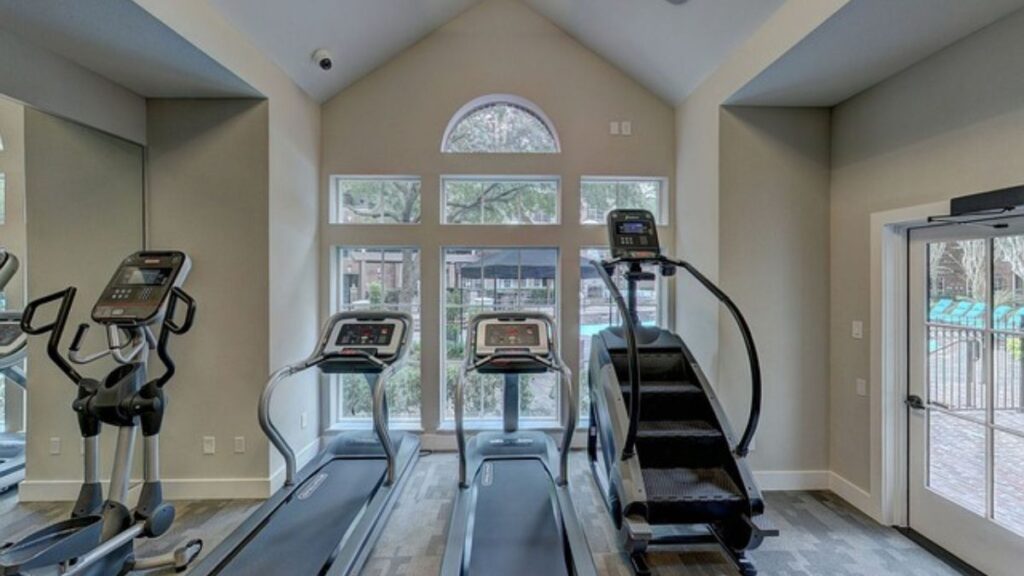Introduction:-
Tech-Driven Fitness: The Evolution of Home Workouts in 2024

In 2024, home workouts are no longer just a convenient alternative to the gym; they have become a primary fitness solution for millions. This evolution is largely driven by technological advancements that have transformed the way we exercise at home. From smart equipment to interactive platforms, technology is at the forefront of this fitness revolution. Let’s explore how tech-driven fitness is shaping home workouts this year.
The Evolution of Home Workouts
The Rise of Smart Fitness Equipment
One of the most significant advancements in home fitness is the integration of smart technology into exercise equipment. Brands like Peloton, NordicTrack, and Echelon are leading the way with innovative products that offer immersive workout experiences. These machines are equipped with touchscreens, live and on-demand classes, and real-time performance tracking. This means that users can enjoy a gym-quality workout without ever leaving their living room.
Virtual Reality Workouts
Virtual reality (VR) is another exciting trend in home fitness. VR workouts provide a fully immersive exercise experience, transporting users to virtual environments where they can engage in various physical activities. Companies like Supernatural and FitXR are pioneering this space, offering VR fitness programs that range from boxing and dance to high-intensity interval training (HIIT). By making workouts more engaging and enjoyable, VR is helping to keep fitness enthusiasts motivated and consistent.
AI-Powered Personal Training
Artificial intelligence (AI) is revolutionizing personal training by providing customized workout plans and real-time feedback. AI-driven apps like Freeletics and Fitbod analyze users’ performance data and adjust their training programs accordingly. This personalized approach ensures that workouts are tailored to individual fitness levels and goals, maximizing effectiveness and minimizing the risk of injury.
Wearable Fitness Technology
Wearables, such as smartwatches and fitness trackers, continue to play a crucial role in the evolution of home workouts. Devices from brands like Fitbit, Apple, and Garmin monitor heart rate, sleep patterns, and other vital metrics. These insights allow users to track their progress, set goals, and stay motivated. Additionally, many wearables now offer guided workouts and integration with other fitness apps, creating a seamless and interconnected fitness ecosystem.
Online Fitness Communities
Social interaction is a key motivator in maintaining a regular workout routine. Online fitness communities provide a platform for users to connect, share their progress, and support each other. Platforms like Strava, MyFitnessPal, and the Peloton community offer social features that make home workouts more interactive and enjoyable. These communities help users stay accountable and inspired by being part of a larger fitness movement .
Streaming Fitness Classes
Streaming services have brought the gym experience into our homes. From yoga and pilates to strength training and cardio, there are countless options available to suit every preference and fitness level. Services like Apple Fitness+, Beachbody On Demand, and Les Mills On Demand offer extensive libraries of workouts led by professional trainers. With the ability to stream classes on demand, users can exercise whenever it fits their schedule.
The Impact of 5G Technology
The rollout of 5G technology is set to enhance the home workout experience further. With faster and more reliable internet connections, live-streamed classes and interactive workout platforms will become even more accessible and seamless. This technological advancement will enable higher-quality video streaming, reducing latency and improving the overall user experience.
What are the latest trends in home workouts in 2024?.
The latest trends in home workouts for 2024 reflect the evolving preferences and technological advancements in fitness. Here are some key trends:

- Virtual Reality (VR) Workouts:
- VR technology is making home workouts more immersive. Fitness platforms are integrating VR to create engaging environments for activities like boxing, dance, and yoga.
- AI-Powered Personal Training:
- AI-driven apps and devices are providing personalized workout plans, real-time feedback, and adjustments based on performance and goals. This allows for a more customized and efficient workout experience.
- Smart Home Gym Equipment:
- Smart equipment like Peloton bikes, Mirror, and Tonal are gaining popularity. These devices offer interactive classes, progress tracking, and a sense of community.
- Wearable Technology:
- Advanced wearables such as smartwatches and fitness trackers are now equipped with more accurate health metrics, including heart rate variability, sleep patterns, and stress levels, helping users optimize their workout routines.
- On-Demand Fitness Classes:
- Streaming services and apps provide access to a vast library of workout classes that can be done anytime, anywhere. This includes everything from HIIT and strength training to pilates and barre.
- Hybrid Workout Models:
- Combining home workouts with occasional gym visits or outdoor activities is becoming more common. This flexible approach caters to different fitness needs and preferences.
- Functional Fitness and Mobility Training:
- There is an increased focus on workouts that enhance daily movement and overall functionality, including mobility exercises, balance training, and bodyweight exercises.
- Mental Health Integration:
- Workouts that combine physical fitness with mental well-being practices, such as yoga, meditation, and breathwork, are on the rise. These holistic approaches help address both physical and mental health.
- Compact and Space-Saving Equipment:
- With space being a constraint for many, compact and multifunctional fitness equipment like foldable treadmills, adjustable dumbbells, and resistance bands are in demand.
- Social Fitness Apps:
- Apps that incorporate social features, allowing users to workout with friends or join fitness communities virtually, are growing in popularity. These platforms provide motivation and accountability.
- Nutritional Integration:
- Fitness apps and devices are increasingly offering nutritional guidance and meal planning services, helping users align their diet with their fitness goals.
These trends highlight a shift towards more personalized, convenient, and holistic approaches to fitness, leveraging technology to enhance the home workout experience.
What are the benefits of using smart fitness equipment at home?
Using smart fitness equipment at home offers a variety of benefits that enhance the overall workout experience and contribute to better health outcomes. Here are some key advantages:

- Personalized Workouts:
- Smart fitness equipment often comes with AI-driven features that create customized workout plans based on your fitness level, goals, and progress. This ensures that your workouts are tailored to your specific needs.
- Real-Time Feedback:
- These devices provide immediate feedback on your form, performance, and intensity. This helps you make necessary adjustments during your workout, reducing the risk of injury and maximizing effectiveness.
- Convenience and Flexibility:
- Having smart fitness equipment at home eliminates the need to travel to a gym, allowing you to work out at any time that suits your schedule. This flexibility can lead to more consistent exercise habits.
- Variety of Workouts:
- Many smart fitness devices offer a wide range of workout options, from strength training and cardio to yoga and pilates. This variety helps keep your fitness routine interesting and prevents boredom.
- Motivation and Engagement:
- Interactive features, such as virtual classes, leaderboards, and community challenges, keep you motivated and engaged. Some equipment also offers gamified workouts, making exercise more enjoyable.
- Progress Tracking:
- Smart fitness equipment tracks various metrics, such as calories burned, heart rate, workout duration, and more. This data helps you monitor your progress over time and adjust your routine to meet your goals.
- Integration with Other Devices:
- These devices often integrate with other smart home systems and fitness apps, allowing for a seamless experience. You can sync your workout data with health apps, smartwatches, and other wearables.
- Space Efficiency:
- Many smart fitness products are designed to be compact and multifunctional, making them ideal for home use where space may be limited.
- Expert Guidance:
- Access to professional trainers and expert guidance through virtual classes and coaching sessions is a common feature. This provides the benefits of personal training without the need to hire a trainer in person.
- Cost-Effective:
- Over time, investing in smart fitness equipment can be more cost-effective than a gym membership, especially considering the additional features and convenience offered.
- Enhanced Safety:
- The real-time feedback and monitoring features help ensure that you are performing exercises correctly, reducing the likelihood of injuries that might occur without proper form or supervision.
- Holistic Health Monitoring:
- Beyond just fitness, many smart devices monitor overall health metrics such as sleep quality, stress levels, and recovery status, providing a more comprehensive view of your well-being.
By leveraging the advanced features and conveniences of smart fitness equipment, users can enjoy a more effective, engaging, and personalized workout experience right in their own homes.
Conclusion
The evolution of home workouts in 2024 is a testament to the transformative power of technology. As smart equipment, VR workouts, AI-powered training, wearable tech, online communities, streaming services, and 5G connectivity continue to advance, exercising at home has never been more effective or enjoyable. By embracing these innovations, fitness enthusiasts can stay motivated, achieve their goals, and enjoy a dynamic and personalized workout experience from the comfort of their own homes.
References
- “Peloton’s Fitness Revolution: Smart Equipment and Interactive Classes” – Peloton
- “The Best Smart Home Gym Equipment of 2024” – TechRadar
- “Virtual Reality in Fitness: A New Era of Home Workouts” – Supernatural
- “FitXR: Bringing Virtual Reality to Home Workouts” – FitXR
- “AI Personal Trainers: The Future of Personalized Fitness” – Freeletics
- “How Fitbod Uses AI to Customize Your Workouts” – Fitbod
- “The Top Wearable Fitness Tech in 2024” – Fitbit
- “How Apple Watch is Revolutionizing Fitness Tracking” – Apple
- “The Power of Online Fitness Communities” – Strava
- “Peloton’s Community: Connecting Through Fitness” – Peloton
- “Streaming Fitness Classes: A Guide to the Best Services” – Apple Fitness+
- “Les Mills On Demand: Bringing the Gym Home” – Les Mills
- “5G and Its Impact on Home Fitness Technology” – Verizon
- “How 5G Will Transform Streaming Workouts” – Forbes
